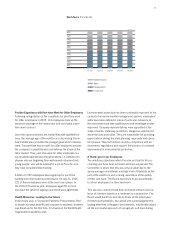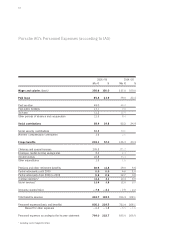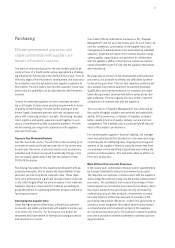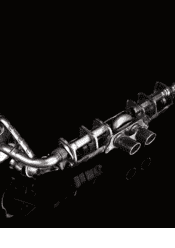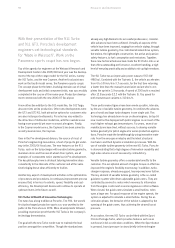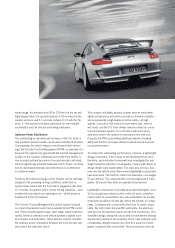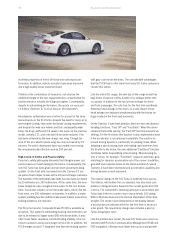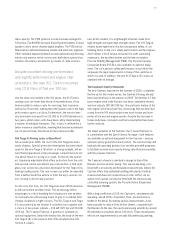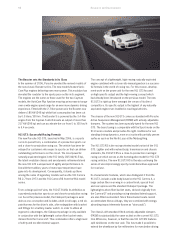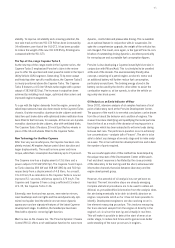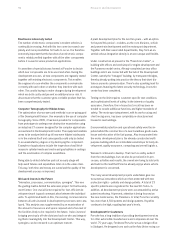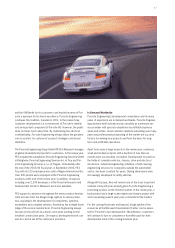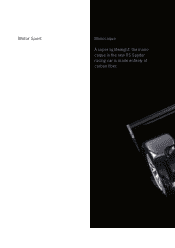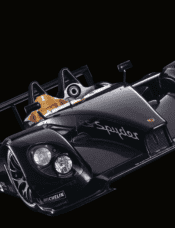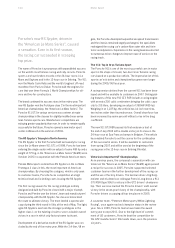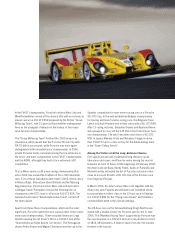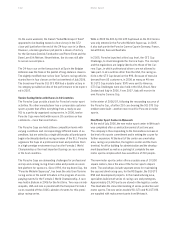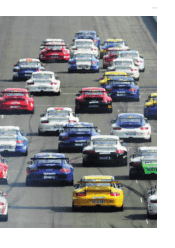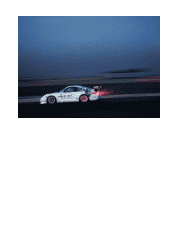Porsche 2005 Annual Report Download - page 96
Download and view the complete annual report
Please find page 96 of the 2005 Porsche annual report below. You can navigate through the pages in the report by either clicking on the pages listed below, or by using the keyword search tool below to find specific information within the annual report.
94
The Boxster sets the Standards in its Class
In the summer of 2006, Porsche unveiled the revised models of
the now classic Boxster series. The new models feature Vario-
Cam Plus engines delivering even more power. This evolution has
elevated the roadster to the sporty pace-setter in its segment.
The engines are the same as those used for the two Cayman
models, the VarioCam Plus function ensuring an increase in torque
over a wide engine speed range for an even more dynamic driving
experience. Fitted with the 2.7-liter power unit, the Boxster now
delivers 180 kW (245 hp) whilst fuel consumption has been cut
by 0.3 liters/100 km. The Boxster S is powered by the 3.4-liter
engine from the Cayman S which boasts an output of more than
217 kW (295 hp) and can accelerate the car from 0 to 100 km/h
in 5.4 seconds.
911 GT3: Successful Racing Formula
The new Porsche 911 GT3, launched in May 2006, is a sports
car in its purest form, a combination of a production sports car
and a close-to-production racing car. The vehicle has been de-
veloped for customers who expect a sports car that can deliver
outstanding performance on the circuit. The most powerful
naturally-aspirated engine in the 911 family (305 kW/415 hp),
the latest-evolution chassis and aerodynamic refinements lend
the new 911 GT3 a unique level of agility and performance. In
line with the tradition, years of motorsport experience have
gone into its development. Consequently, it stands up there
among the ranks of legendary models such as the 911 Carrera
RS 2.7 from 1973 and the 911Carrera RS from the 964 model
series.
From a design point of view, the 911 GT3 fulfils its definition as
a purebred production sports car and close-to-production racing
car. As on the previous model, the Clubsport package is avail-
able as a no-cost option and includes a bolt-in roll cage, a red six-
point harness for the driver’s side, a fire extinguisher with bracket
and fittings for a battery master switch. In order to utilize all
ergonomic advantages, the Clubsport package is only available
in conjunction with the lightweight carbon fiber bucket seats
derived from the Carrera GT. This combination offers a high level
of safety and excellent lateral support.
The concept of a lightweight, high-revving naturally-aspirated
engine combined with a close ratio manual gearbox is a success-
ful formula in the world of racing too. For this reason, develop-
ment work on the power unit for the new 911 GT3 focused
on high specific output and the high-revving concept which
had already been introduced on the previous model. The new
911 GT3 is right up there amongst the cream of its direct
competitors. Its specific output is the highest of any naturally-
aspirated engine ever installed in road-legal vehicles.
The chassis of the new 911 GT3 comes as standard with Porsche
Active Suspension Management (PASM) with actively adjustable
dampers. The system has been specially tuned for the new 911
GT3. The basic tuning is comparable with the Sport mode on the
911 Carrera models and provides the right conditions for out-
standing driving dynamics, even on circuits with partially uneven
surfaces such as the North Loop at the Nürburg Ring.
The 911 GT3 RS is the racing-oriented model variant of the 911
GT3. Lighter and with evolved body, transmission and chassis
elements, the 911 GT3 RS is a close-to-production road-legal
racing car which serves as the homologation model for 911 GT3
racing vehicles. The new 911 GT3 RS is thereby continuing the
series of uncompromisingly sporty model derivatives approved
for road use.
Its characteristic features, which also distinguish it from the
911 GT3, include a wide body based on the 911 Carrera 4, a
large carbon fiber rear wing in a carbon finish, special front
and rear aprons and the standard Clubsport package. The
lightweight carbon fiber bucket seats, derived originally from
the Carrera GT and providing racing-standard lateral support,
are also fitted as standard. Since these bucket seats cannot
accommodate thorax airbags, they are combined with energy-
absorbing impact elements (known as “door pads”).
The chassis with standard-fitted actively adjustable dampers
(PASM) is substantially the same as that on the current 911 GT3.
One difference, however, is that the new 911 GT3 RS features
split wishbones on the rear axle. This has made it possible to
extend the wheelbase by five millimeters for even better driving
Research and Development



